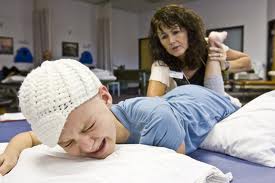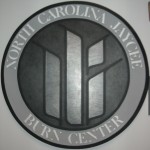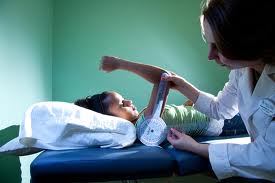My inspiration for this capstone project developed while completing a clinical rotation at UNC Hospitals Jaycee Burn Center and gaining experience in the specialized field of burn rehabilitation physical therapy. I was fortunate enough to be able to learn about the unique immediate needs and complications, surgical techniques, types, and medical management of all types of burn injuries and severe skin conditions as well as the deeply personal and emotionally challenging nature of burn care.
I was very much affected by the patients I treated and their families, particularly the cases involving children. It was difficult for me to see a child in pain and struggling to recover from these traumatic injuries, but that was nothing compared to what the parents or caregivers of these children were experiencing. The families I interacted with were generally in great amounts of distress, overwhelmed, in shock, and extremely emotional due to the unexpected and often severe injury sustained by their child. There are so many unique medical needs after an individual experiences a burn injury, and the acute stage of treatment can certainly be confusing and difficult to process. Education about what their child was experiencing and why the medical interventions provided were being performed was crucial to reduce anxiety and gain their participation in their child’s recovery, however, I often feared that verbal communication might not have been the most effective at times due to the emotional state of the individual and their inability to fully attend to and process the information being provided. I wished I had a comprehensive educational tool that I could leave with them to peruse, absorb, and refer to when they felt better able to seek information about their child’s condition. I also thought a written educational handout would be a valuable tool to be able to send home with them, as it could be referenced after leaving the hospital and provide a source of more permanent and lasting information than verbal communication.
Patient and family education is an incredibly important component of burn rehabilitation. Due to the development of scar tissue as the skin heals, contracture prevention is one of the greatest areas of focus of physical therapy interventions. Unfortunately, stretching the injured tissue can be quite painful and cause a great amount of patient discomfort and anxiety. Extensive patient education must be provided on the importance of stretching to maintain range of motion and explain how noncompliance can result in permanent loss of function, especially for burns crossing a joint line and massive burn injuries in which a large amount of the total body surface area is affected.

Unfortunately, patient education is particularly difficult for pediatric patients who have sustained a burn injury, as it is not always possible to reason with children and enable them to understand the long term complications that will result from avoiding activities that may elicit pain. Caregiver education is crucial to gaining compliance and optimal long term outcomes through their encouragement, support, participation in, and facilitation of interventions.
I wanted to develop an educational intervention that would help parents and caregivers of children with burn injuries to understand not only what the purpose of physical therapy is and how it can help their child, as well as the importance of their child’s participation in PT, but also provide a basic general guide of what to expect after a burn injury, knowledge of emotional support resources, and how they can become involved in the rehabilitation process. Caregiver involvement not only aids the child’s recovery, but also provides the caregiver with a sense of worth and value during a difficult and emotionally challenging process. With all of these considerations in mind, and with the much appreciated guidance of my capstone committee members, Keith Jacobson and Benita Wicker, physical therapists at the UNC Hospitals Jaycee Burn Center, I developed a comprehensive educational intervention for caregivers of children with burn injuries.
Great consideration was given to the target audience of this material, and how to best make it appropriate, comprehendible, appealing, and enhance reader learning. The Center for Disease Control’s guidelines for health literacy as well as Doak et al’s suggestions for patient education of low-literacy individuals were incorporated and the effectiveness of their application was evaluated by a health literacy assessment.1,2 In addition, this educational handout went through a series of revisions based upon feedback and communication with my committee members, who provided midterm and final evaluations of the material which can be found below:
Keith Jacobson’s midterm evaluation Benita Wicker’s midterm evaluation
Keith Jacobson’s final evaluation Benita Wicker’s final evaluation
This educational tool was based upon an extensive literature review and incorporated evidence concerning the immediate physiologic effects and current medical management practices of burn injuries and how physical therapy interventions can address these impairments to produce optimal long term outcomes.4-10,13-18 In addition to physiologic impairments, psychological health and family support were also stressed in the literature as important correlates to maintaining best possible quality of life and long term function in children who had sustained burn injuries, and this information was integrated to the educational handout as well.3,11,12 Please take a look at the evidence table summarizing these studies and my research paper, which evaluates and applies the information gained from this literature review to clinical practice and investigates its value for physical therapists treating children with burn injuries.
The educational resource I developed will be submitted to a review board at UNC Hospitals to gain approval for distribution to patients and their families, and Keith is confident that it should easily gain approval and be able to be utilized by physical therapists in the Jaycee Burn Center. I hope it does indeed gain authorization for distribution and that it will enhance education for caregivers of children with burn injuries undergoing physical therapy.
I would like to thank Keith Jacobson, Benita Wicker, Luis Reveles, Karen McCulloch, and Mike McMorris for their guidance and support with the development of this project, and all of those who review and provide comments concerning this educational intervention.
Thank you so much for your contributions!
References:
- Centers for Disease Control and Prevention. 1999. Scientific and Technical Information: Simply Put, 2nd Edition. Atlanta: Centers for Disease Control and Prevention. Pages 1-42.
- Doak CC, Doak LG and Root JH. 1996. Teaching Patients with Low Literacy Skills, 2nd Edition. Philadelphia: Lippincott. Ch. 4, page 11. Access at http://www.hsph.harvard.edu/healthliteracy/doak4.pdf
- Sheridan RL, Hinson MI, Liang MH, et al. Long-term outcome of children surviving massive burns. JAMA. 2000;283:69-73.
- Suman OE, Spies RJ, Celis MM, Mlcak RP, Herndon DN. Effects of a 12-wk resistance exercise program on skeletal muscle strength in children with burn injuries. J Appl Physiol. 2001;91:1168-1175.
- Pham TN, Cancio LC, Gibran NS. American Burn Association practice guidelines burn shock resuscitation. J Burn Care Res. 2008;29(1):257-266.
- Grunwald TB, Garner WL. Acute Burns. Plast. Reconst. Surg. 2008;121(5):311-319.
- Sheridan RL, Remensnyder JP, Schnitzer JJ, Schulz JT, Ryan CM, Tompkins RG. Current expectations for survival in pediatric burns. Arch Pediatr Adolesc Med. 2000;154:245-249.
- Al-Mousawi AM, Williams FN, Mlcak RP, Jeschke MG, Herndon DN, Suman OE. Effects of exercise training on resting energy expenditure and lean mass during pediatric burn rehabilitation. J Burn Care Res. 2010;31:400-408.
- Jeschke MG. Mlcak RP. Finnerty CC, Norbury WB, Gauglitz GG, Kulp GA, Herndon DN. Burn size determines the inflammatory and hypermetabolic response. Critical Care. 2007;11(4):90-111.
- Neugebauer CT, Serghiou M, Herndon DN, Suman OE. Effects of a 12 week rehabilitation program with music & exercise groups on range of motion in young children with severe burns. J Burn Care Res. 2008;29:939-948.
- Beard SA, Herndon DN, Desai M. Adaptation of self-image in burn-disfigured children. J Burn Care Rehabil. 1989;10:550-554.
- Baker CP, Russell WJ, Meyer W, Blakeney P. Physical and psychologic rehabilitation outcomes for young adults burned as children. Arch Phys Med Rehabil. 2007;88(2):57-64.
- Alloju SM, Herndon DN, McEntire SJ, Suman OE. Assessment of muscle function in severely burned children. Burns. 2008;34:452-459.
- Przkora R, Herndon DN, Suman OE. The effects of Oxandrolone and exercise on muscle mass and function in children with severe burns. Pediatrics. 2007;119(1):109-116.
- McEntire SJ, Herndon DN, Sanford AP, Suman OE. Thermoregulation during exercise in severely burned children. Pediatric Rehabilitation. 2006;9(1):57-64.
- Schneider JC, Holavanahalli R, Helm P, Goldstein R, Kowalske K. Contractures in burn injury: defining the problem. J Burn Care Res. 2006;27:508-514.
- Okhovation F, Zoubine N. A comparison between two burn protocols. Burns. 2007;33(4):429-434.
- Junker JPE, Kratz C, Tollback A, Kratz G. Mechanical tension stimulates the transdifferentiation of fibroblasts into myofibroblasts in human burn scars. Burns. 2008;34(7):942-946.




6 Responses to “An educational intervention for caregivers of children with burn injuries”
jlkowals
Kmac,
Thank you for bringing the issue with the images I utilized to my attention. I do not have a reference list for those, but will hop right on that. I hope that doesn’t prevent this from being approved for distribution! If this is a major issue, I will get in contact with someone at the burn center and see if I can go in and take some photographs of patients and their families who would provide written consent and replace the images with these. Thanks again for making me aware of this potential complication – I had not considered it!
Jesse
jlkowals
Kyle, Amanda, and Libby,
Thank you so much for the positive feedback! I’m glad you found my handout to be an appropriate and beneficial educational material for not only patients but therapists as well, and that you seem to echo some of the many reasons I felt this was a worthwhile and beneficial endeavor! I’m also really happy to hear you thought it was visually appealing… I worked incredibly hard (and slightly obsessively) to try to make it so. 🙂 Thanks for all your support!
Jesse
Libby
What great coverage for such a difficult subject! I found your educational materials to be clear and up-beat as well as comforting. Parents with a child in the burn center might not have time to fully ingest all the information that is being put in front of them, it’s great to have something to bring home and read after the dust settles. Your booklet provides a lot of great tips on how to be a good parent at this stage, a stage when many parents feel helpless. You did a great job describing their role and how they can help.
Amanda Reed
Good job Jesse! I think that your handout not only looks amazing, but would also be a great educational resource for parents and caregivers. I have not had much experience with burn care, but I could see the parents being very overwhelmed by all the information they are being told and I think that this handout would provide them with a source that they can read over on their own and reference as needed to find information. I am sure that this will be a very helpful tool to use in any burn clinic.
mcculloc
Hi Jesse, You’ve done a great deal of thoughtful work here and your brochure really does seem to fill a niche – clearly from the feedback from Benita and Keith, they see it as ready for use in their environment. Great job on the health literacy assessment – you were very careful in how you conducted that. It will be interesting to see how the review goes from the UNC entity that decides on whether things can be used for pts.
The images and pictures that you used in the brochure….do you have clear indications that those are free for use in this way? That may be one stumbling block in the process, so you may want to develop a list of sources for those pictures to make sure there isn’t an issue related to consent for a picture to be used in a brochure that is distributed…..
Very nice work and I’m happy to see you at this point!!!!
YAY you!!!
kmac
Kyle Rascoe
Jesse,
This project is awesome! I love that you chose a unique patient population and filled a gap that the rest of us have no clue about. Your educational handout is fantastic! I’m so impressed with the layout, graphics, pictures, colors, and information. You provide the information in a clear way that is not overwhelming to patients and families but still answers the major questions for them. Such a great idea! If I ever come across a burn patient I will definitely give them your handout. Fantastic job!